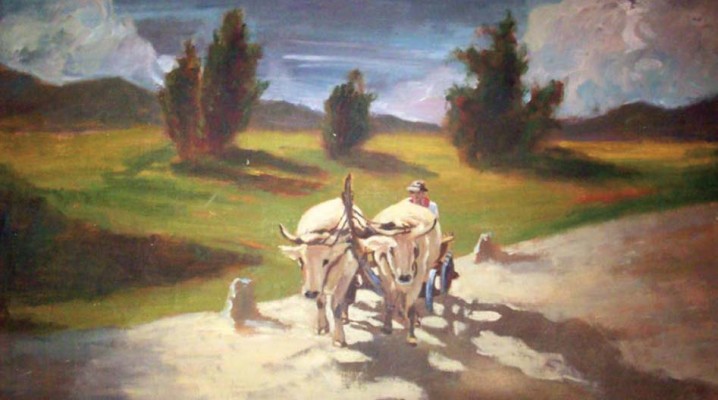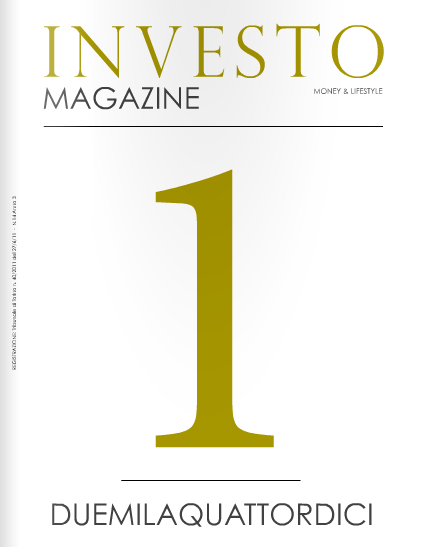CATY TORTA
CHILDWOOD
Caty Torta comes from a middle class family that prepared her to a traditional lifestyle.
She learnt how to embroider, cook and play piano but the passion for art and drawing was bursting inside her.
At 6-years old she drawn a dying child that left her parents speechless.
At 12-years old, with only same basics of painting, she did a naturalist painting of a oxcart, mastering a professional like technique and perspective. She once told laughing that the animals were “very fast” : she had to step back while portraying them because the animal were coming towards her!
“ The Oxen” 1932
ADOLESCENSE
The shy and quite girl is now a beautiful and desirable woman but the only thing she could think of is painting
(Caty Torta )
In the meantime the Second World War was showing in all its tragedy. Following her passionate temper she became a Red Cross nurse to help the young men of her generation. She enlisted as a volunteer but she was infected with the terrible respiratory disease of those times. Her parents wanted to save her and they brought her back home.
Instead of looking for an husband, Caty was looking for a good painting teacher: she met Tullio Alemanni who taught her classic figurative drawing. But after a while the student was looking for new experiences… The new wave of modernity was spreading in Europe and the feeling of existentialism and abstractionism was in the air.
THE PASSION FOR CAR RACING
Another demon, besides painting, was in her thoughts: car racing
Helped by her father and by her competitiveness she became one of the few girls holding a license for driving sport cars. On board of a Lancia Aprilia she enrolled in quite a few races, winning the S.Remo. In those days women did not even drive while she, instead, was competing with men on a time trial. She then enrolled in sprint races; she took part in the Millemiglia, that she struggled to finish it.
( Caty on Porsche )
THE MUSIC
As was the custom in those days, when she was 6-years old she received a piano and she started music appreciation classes. Caty burst into tears: ” I want to paint and just paint”. Despite this firm statement, during all her life she will show a great attachment to music.
( drawing of her piano )
With great surprise of her parents, at 8-years old she played traditional music in an Alpine troupes band.
When she was still a child, the love for good music will urge her to see the long opera performances at the Regio Theatre.
Many years later, in occasion of the painting exhibition for the opening of the new Regio Theatre, she will be awarded a prize for an original picture resulting from that experience: the music, the old furnishings, the blaze and the new innovative architecture just realized.
The Regio Theatre
CASORATI
Caty was full of ideas and passion. She felt she needed to be involved with a great Maestro.
Back then, Felice Casorati was the reference model in the cultural and artistic life of Turin. A beacon.
The maestro Allemanni, being the first one to recognize he could not check his student impulses anymore, addressed her in Via Mazzini 52 to see the Maestro Casorati.
With great humility but well aware of the quality of her work, she brought her drawings and paintings for viewing.
Her painting was built “on volumes” and it was completely different from the new way of understanding art: she showed him also some personal canvas, among which “La Tosse” and “Movimento 2000” that impressed Casorati.
From some friends in common, she would find out the same day that the Maestro commented on her: “That girl has talent” “I will take her on as an apprentice”.
Caty became one of the most disciplined students. She drew up to 15 hours a day. Each morning she used to bring Casorati an extra drawing made at night! It is not easy to change how you work. But she did.
One day, when she was called to restore a Tintoretto, she realized she did not stay up all those nights for nothing.
Casorati appreciated her because of her painting based on her own ideas, avoiding to make ugly copies of artworks.
PARIGI
The Torta family had not seen nothing yet about her girl. She was definitely truly ahead of her time. A modern woman, a close observer of changes in customs . She had never been a rebel but, after all, she had never had an insulting or offensive behavior toward anyone.
These qualities were fundamental to obtain the visa in Paris in order to study alone.
Casorati himself saw for his student a future as abstractionist and he encouraged her to go to the Paris Academy.
Another revolution. Another beginning. The model that, at Casorati’s , used to pose for three hours to be portrayed in the same position, in Paris she turned every seven minutes. Caty cried but she did not give up. Besides her Germans, Chinese, Iranians were sketching fast and they finished the drawing in time: she had to make it.
She will become abstractionist , but gradually, excluding every day what was not essential.
Anna Maria Brizio, art historian and woman just like her, will always encourage her work with respect and affection.
SILENT WORK
In a world that repaid who showed off and organized the commerce of art, Caty Torta stepped back.
What was important to her were her artwork and not showing off. She did not form any connection with any art dealers or art gallery owners. She did not want any advises or orders. She was isolated from the rest but she worked even more than before.
She then got married with a man that was able to let her be free. He was a doctor but also a violinist and a painter.
A figure that today could not exist. Left a widow before long, Caty Torta devoted herself to her only child, refusing a chair at university.
Strangely enough, in those years her continuous and inexhaustible desire for painting will amplify even more. Her paintings, but not her, will cross the borders over and over to be part of collective exhibits and cultural events. The only condition is for them to be able to return the love and commitment she gave them.
A love and a commitment that last a lifetime.
CATY TORTA
L’INFANZIA
Caty Torta nasce da una famiglia borghese che la prepara per una vita tradizionale.
Impara a ricamare,cucinare ed a suonare il pianoforte ma dentro di sè irrompe come una fucilata la passione per il disegno e per l’arte.
A sei anni disegna un bimbo morente che lascia di stucco i genitori.
A dodici anni ,con pochi rudimenti di pittura, realizza un quadro naturalista raffigurante un carro di buoi. La tecnica e la prospettiva sono già da professionista. Sostiene ridendo che i buoi sono animali ” velocissimi” poiché li stava ritraendo dal vero, indietreggiando, mentre questi avanzavano sulla strada!
L’ADOLESCENZA
La bimba timida ed introversa diventa una ragazza bella e corteggiata ma lei non ha occhi che per la pittura.
(Caty Torta )
Intanto la seconda guerra mondiale si manifesta in tutta la sua gravità . Seguendo il proprio carattere passionale diventa crocerossina per aiutare i ragazzi della sua generazione. Si arruola ma viene contagiata dalla terribile malattia respiratoria di quei tempi. I genitori intervengono per salvarla e la riportano a casa.
Invece che di un marito Caty è alla ricerca di un buon maestro di pittura : e lo trova in Tullio Alemanni , dal quale impara il rigore ed il disegno figurativo classico. Ma già dopo poco tempo la discepola cerca nuovi lidi..l’Europa parla moderno e nell’aria si respira l’esistenzialismo e l’ astrattismo.
LA PASSIONE PER LE GARE AUTOMOBILISTICHE
Un altro demone ,dominante quasi come la pittura ,anima i suoi pensieri : le corse in macchina.
Aiutata dal babbo e forte di uno spirito innato per le competizioni non esita a diventare una delle poche ragazze in possesso di patente sportiva. A bordo di una Lancia Aprilia si iscrive a numerose corse di regolarità vincendone anche una a S.Remo. In quei tempi le donne non guidavano neppure mentre lei sfidava gli uomini più esperti fino a piegarli alla dura legge del cronometro. Successivamente si iscrive a gare di velocità compresa la Mille-Miglia che riuscirà a portare a termine solo con un grandissimo sforzo.
(Caty su Porsche )
LA MUSICA
A sei anni giusti arriva in casa il pianoforte come l’ educazione musicale di quei tempi imponeva. Caty Torta scoppia a piangere: “Voglio dipingere e solo sempre dipingere”.In verità da questa affermazione categorica nasce al contrario un’ affinità per la musica che rimarrà costante per tutta la vita.
( disegno del suo pianoforte )
A otto anni suona a sorpresa musiche tradizionali con una banda di Alpini sorprendendo i genitori stessi.
La buona musica poi la fa assistere ,ancora bambina, alle lunghe rappresentazioni operistiche del Regio.
Molti anni dopo per l’inaugurazione del Nuovo Regio verrà premiata nell’omonimo concorso di pittura esponendo un quadro originale ,frutto di quell’esperienza, che riassumeva le musiche, gli antichi arredi,il rogo e la nuova innovativa architettura appena realizzata.
CASORATI
Caty è un vulcano di idee e di passione. Percepisce la necessità di respirare l’aria di un grande Maestro.
Felice Casorati in quei tempi era al centro della vita culturale ed artistica di Torino. Un faro illuminante .
Il maestro Allemanni ,lui per primo convinto di non poter più contenere gli slanci della sua allieva ,la indirizza in Via Mazzini 52 dal Maestro Casorati.
Con grande umiltà ma sempre consapevole del proprio lavoro porta in visione disegni e tavole.
La sua pittura è costruita “ a volumi “ e risulta radicalmente diversa dal nuovo modo di intendere l’arte: mostra però anche alcune tele personali tra le quali “ La Tosse” e “Movimento 2000”che sorprendono Casorati.
Da alcuni amici in comune viene a sapere che il giorno stesso il Maestro dice di lei :“Quella ragazza ha talento” “la prendo a bottega”
Caty diventa la più disciplinata delle allieve. Disegna fino a 15 ore al giorno. Porta tutte le mattine a Casorati un disegno extra che realizza nella notte! Non è facile cambiare impostazione. Ma ci riesce.
Un giorno chiamata a restaurare un Tintoretto si accorgerà di non esser stata sveglia inutilmente tutte quelle notti.
Viene apprezzata da Casorati perché dipinge con idee proprie evitando di riprodurre , in brutto, le opere del Maestro .
PARIGI
La famiglia Torta doveva ancora assistere a nuove e difficili imprese della sua unica figlia. Sicuramente una grande anticipatrice dei tempi. Una donna moderna ed attenta al mutamento dei costumi . In definitiva mai ribelle od offensiva, soprattutto mai oltraggiosa nei confronti di alcuno.
Queste qualità saranno la garanzia per ottenere il permesso di soggiornare a Parigi da sola per studio.
Casorati stesso intravede per l’allieva un futuro da astrattista e la indirizza all’Accademia di Parigi.
Ancora una rivoluzione. Ancora un inizio. La modella che da Casorati posa tre ore per poter essere ritratta nella stessa posizione a Parigi gira ogni sette minuti. Caty piange ma non molla. Accanto a lei tedeschi , cinesi ,iraniani schizzano velocemente e riescono ad ultimare il disegno in tempo : deve farcela .
Diventerà astrattista ma per gradi, per sintesi , escludendo ogni giorno tutto ciò che non è essenziale.
Anna Maria Brizio storica dell’Arte e donna come lei la incoraggerà nell’impresa con stima ed affetto.
LAVORO SILENZIOSO
In un mondo che premia chi si mette in mostra e organizza il commercio dell’arte Caty Torta fa un passo indietro.
Per lei contano le opere e non l’esibizionismo. Non si lega a nessun mercante, a nessun gallerista. Non vuole suggerimenti od imposizioni .Resta isolata ma lavora ancora più di prima.
Si è poi sposata con un uomo che ha saputo lasciarla libera. Medico ed anche violinista e pittore.
Una figura che oggi non potrebbe più esistere. Rimasta presto vedova Caty Torta si dedica al suo unico figlio rinunciando all’insegnamento accademico che le era appena stato proposto.
Paradossalmente in questi anni si amplifica ancor di più la sua costante ed inesauribile voglia di dipingere. I suoi quadri, ma non lei ,varcano ripetutamente i confini per partecipare a mostre collettive e manifestazioni culturali . L’unica condizione è che siano capaci di restituirle l’amore e l’impegno che lei gli ha dedicato.
Un amore ed un impegno che durano da tutta una vita.
» 2013 - Numero 5 » Volcano CatyIl vulcano Caty






 youhost
youhost